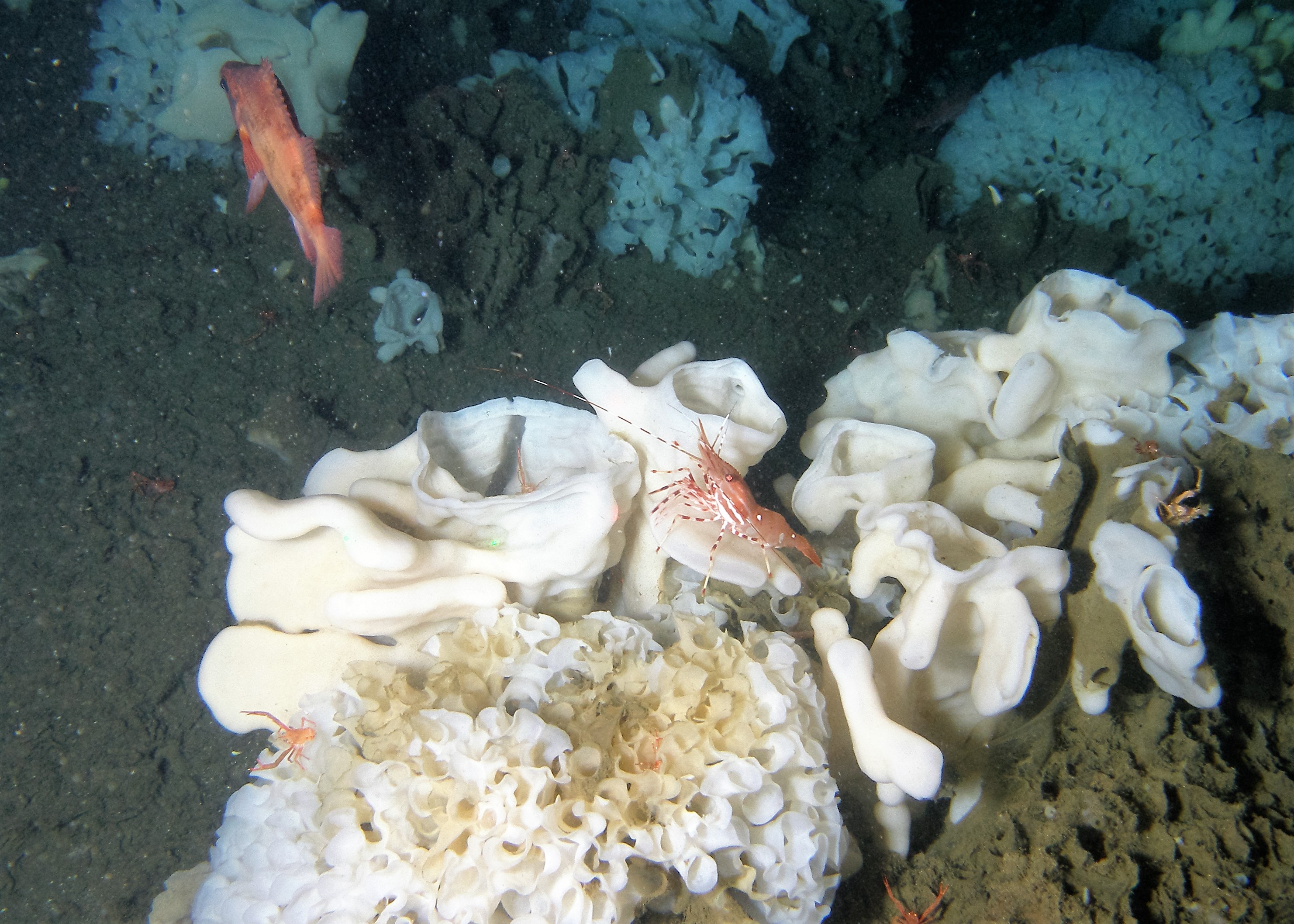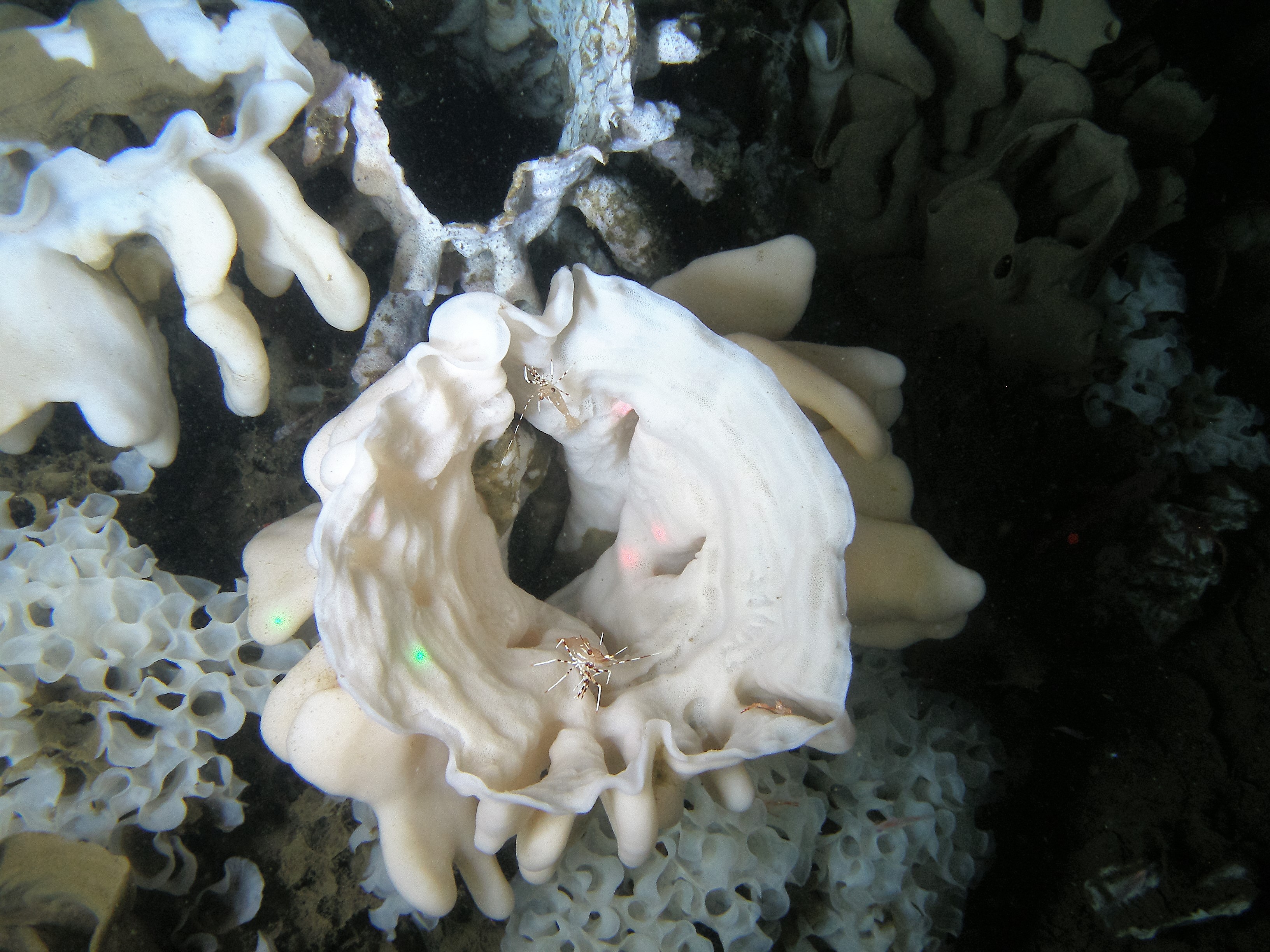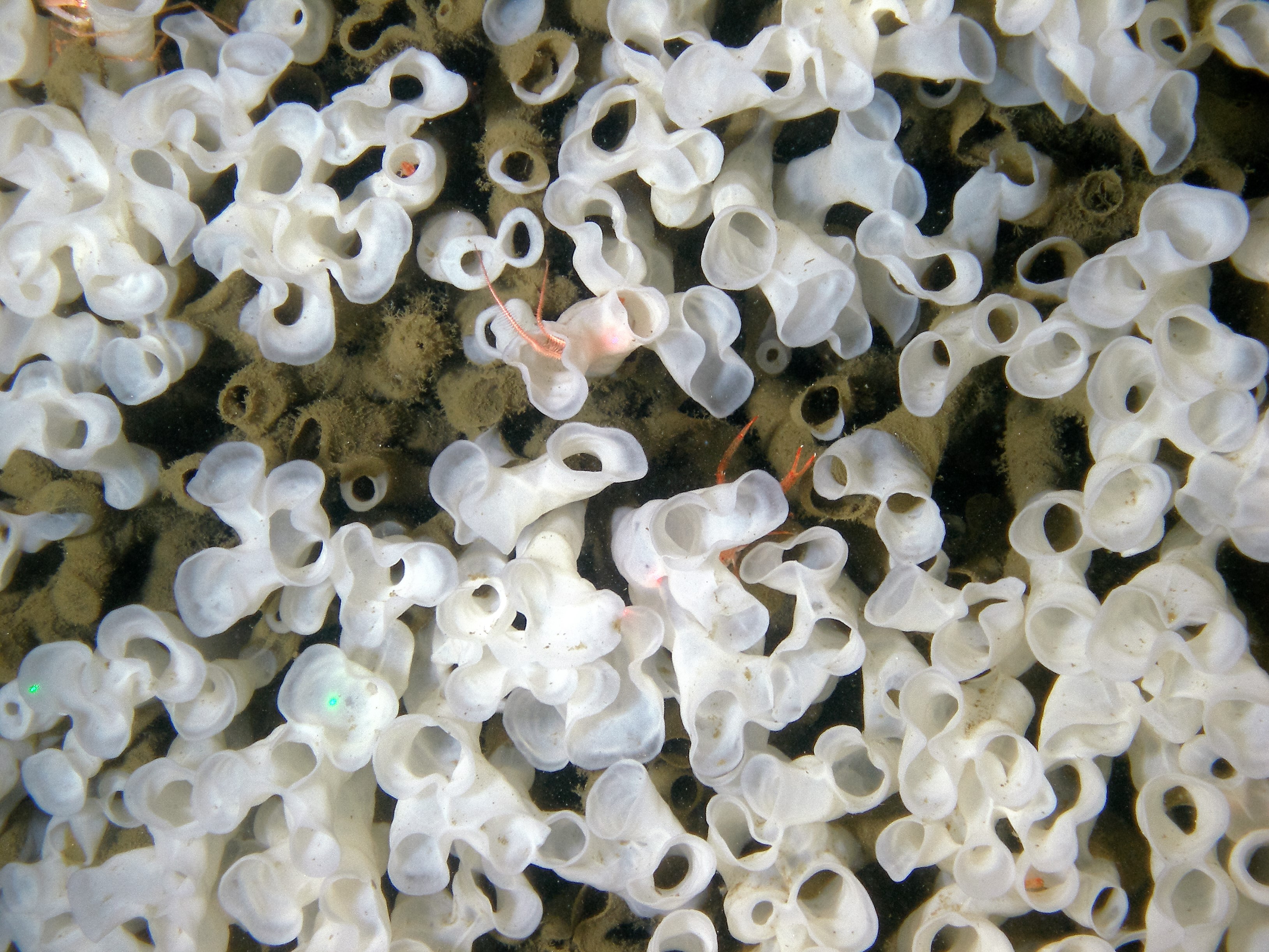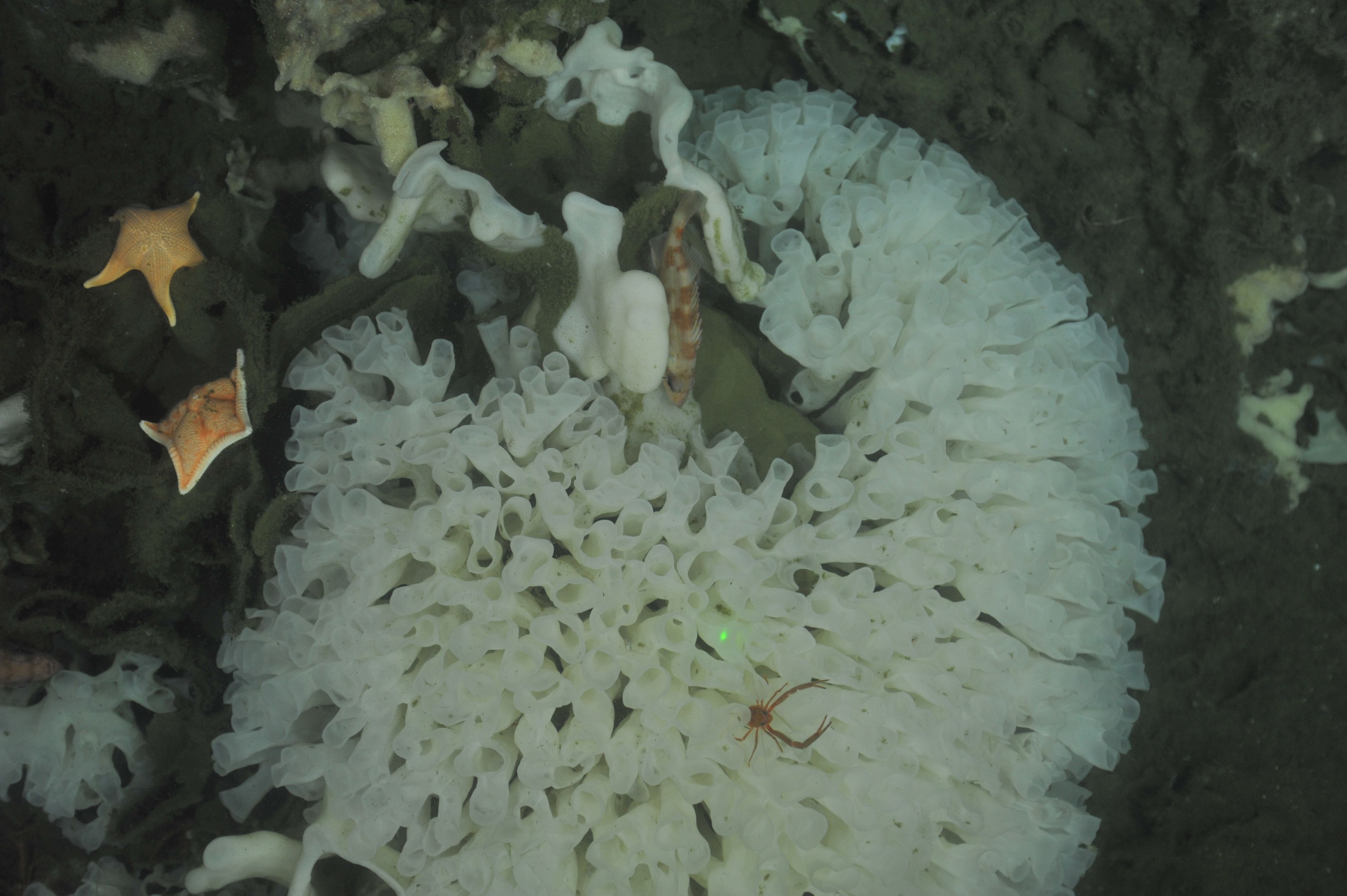By Polina Berliaeva
The world’s oceans in their great vastness support an incredible diversity of aquatic species. But how much do we really know about life beneath the surface?

Many fish species find food and shelter on glass sponge reefs. Photo courtesy: Department of Fisheries and Oceans Canada (DFO)

Kim Conway, Research Scientist, Natural Resources Canada
For instance, in the deep waters off the coasts of B.C. and Alaska, a truly unique community of organisms combines to form glass sponge reefs that were once thought to be extinct. They were first discovered in the late 1980s by Natural Resources Canada (NRCan) scientists including Kim Conway — a discovery so unexpected that scientists often compare it to finding a herd of dinosaurs still roaming the earth.
“One surprising thing this research shows is how little we know about the ocean,” Kim says. And since these reefs can now be studied first-hand, the knowledge they can provide is precious. “They’re the only example on earth that we have to study,” he says, “and they can tell us a lot about what some very ancient and large reef systems would have been like at the time of the dinosaurs.”
A city of glass sponges
Unlike the familiar sponges that form their structures from protein, glass sponges construct their intricate skeletons with a mineral: silica, the primary constituent of glass. The reefs they create grow up to 25 metres tall — comparable to an eight-storey building — and develop slowly over centuries as three species of glass sponges progressively attach themselves to previous generations of sponges.
Higher sea temperatures? Wider consequences
As they are similar to reefs that were once long abundant but became extinct 40 million years ago, the modern glass sponge reefs are seen as so crucial to our understanding of the underwater world that many scientists are seeking their protection as a UNESCO world heritage site. Meanwhile, Kim Conway and other researchers are looking for ways to better conserve and understand this unique reef system, especially under the conditions of today’s changing climate.



The glass sponge reefs, found only in deep water, were once thought to be extinct. Discovered off the coast of B.C. and Alaska in the 1980s, they are now under consideration to be named a UNESCO world heritage site. Pictures courtesy the Department of Fisheries and Oceans Canada and Sally Leys.
“The temperature of the water affects how much oxygen is available for the organisms to live in,” says Kim. “As water heats up, it looses its capacity to carry dissolved oxygen, which is impacting shelf and coastal biological communities, including the glass sponge reefs. And one big effect of climate change in the ocean is that many species are going to be subjected to these changes in oxygenation.”
An undersea world of activity
Glass sponge reefs provide important habitat for other marine life. “Many fish species find homes and food sources in the sponge reef surface, just like on a coral reef,” says Kim.
But while coral reefs rely on sunshine to supply the food they need to form, glass sponge reefs live in water so deep that sunlight can’t reach them. “This means that glass sponges must filter vast amounts of water to find enough of the food that they eat, which is mainly bacteria” says Kim. The sheer volume and high efficiency of this form of feeding are truly impressive: a single small reef filters enough water to fill an Olympic-sized swimming pool in less than 60 seconds.
For more details about the glass sponge reefs, listen to the Simply Science podcast with NRCan scientist Kim Conway.
Text Version
– Joël Houle
Welcome, everyone, to Ask NRCan! I’m your host, Joël Houle, and this is our podcast series where we sit down with our experts to talk about the work that we do here at Natural Resources Canada (or NRCan for short). Today, we’ll be talking about unique reefs that were discovered off the British Columbia coast in the 1980s. For those of you who are new to the show, we call this series “Ask NRCan” because we want to hear from you and learn what interests you in the world around us. The purpose of the show is to share with you not only the type of science that we do but also the reasons why we do it and how they relate to your life. So, at the end of the episode, if you have any questions on today’s topic or on science in general, head to Twitter and tweet at us using the hashtag “#AskNRCAN”. Our experts will do their best to answer all your questions. We release an episode of Ask NRCan on the first Tuesday of each month, so make sure to subscribe so you don’t miss an episode. Okay, let’s meet our guest!
– Joël Houle
My guest today is scientist Kim Conway from the Pacific Geoscience Centre in Sydney B.C. Kim, thank you for joining us.
– Kim Conway
It's great to be here.
– Joël Houle
Perfect. So in the 1980s you were part of an expedition to map the continental shelf in the Pacific Ocean. And during this mission you made a fascinating unexpected discovery. Can you tell us a little bit about it?
– Kim Conway
Sure. The discovery in the 80s was actually on several expeditions. We had a large marine program to map our continental shelf area, which is the shallow part of the ocean adjacent to the continents. So in B.C., that’s the Queen Charlotte Sound and Hecate Strait by the Queen Charlotte Islands — or Haida Gwaii now, pardon me — and north of Vancouver Island. So we had several expeditions to these waters and made these interesting amazing observations on seafloor features that took a long time to actually figure out. It was a couple of years before we actually figured out that these features were all related. All were actually reefs formed by sponges on the seabed. So these reefs were very large but in different forms in different places. So, where you went on the continental shelf, these reefs were different structures, different styles, mounds, ridges, flat areas but all created by the same group of sponges.
– Joël Houle
So what exactly are glass sponge reefs and what makes them so special?
– Kim Conway
The glass sponges, as the name implies, have a skeleton made of glass; so that’s silicon dioxide, just like a window glass. But this is a biologically created glass. So people are familiar with sponges that they use in the baths. These sponges are protein-based sponges. They have a protein skeleton. Sponges that live in the deep sea often have a glass skeleton. And these are the group of sponges that form these large reefs. So they're very fragile. They take a very long time to grow, a few centimetres per year. And the neat thing about these reefs is they grow like a coral reef: one sponge on the other until they can form these fantastically large structures up to 30 metres in height and tens of kilometres in area. So they're basically the size of cities, if the city had eight-storey buildings and widespread low-rise apartment buildings all around it. That's the size of these, what we call, sponge reef complexes.
So these reef areas took, we think, thousands of years to grow. The construction of the reefs is dependent on many factors, and they're unique to this part of the world. We don't find them anywhere else in the world, and we think that their growth is dependent on our high nutrient levels, including silica as a nutrient in the water that's delivered from our mountain ranges. So the rivers wash this silica into the ocean where these sponge reefs can take advantage of this high silica content in the ocean water and build these really large reef structures.
– Joël Houle
How big are the reefs themselves?
– Kim Conway
As you see them on the sea floor in Hecate Strait and Queen Charlotte Sound, are often 20 metres or even taller and they can form pointy mounds or ridges. And in other places they can be very broad, hill-like forms that go on for kilometres. So when we map these structures, they end up, as I mentioned, being much like a city where you have different-sized structures in different parts of the reef complex. And we think this is because there's variability in the delivery of currents that bring the nutrients but also suspended sediment to the reefs to make the reefs grow faster or slower, depending on the condition of the sea floor where the sponges are growing.
– Joël Houle
This discovery, what does it mean for science?
– Kim Conway
Well, I think the biggest thing is it was such a surprise. The marine biology scientific community in Canada, and indeed around the world — that it was kind of a new paradigm that an actual living reef system could exist in deep and cold water off British Columbia. So this was a brand new concept that we had these very complex ecosystems in widespread and deep water on our shelf. So this understanding required changes to fisheries management. So now, in the past fisheries management was based on a single species, a single harvest and without too much consideration about the other players in the ecosystem. So now, fisheries management has moved to ecosystem-based management. And this is required if these reefs are to survive. So longer-term thinking about the habitat requirements for different species.
And that's an important part of the science around these reefs. The reefs take centuries to grow. And these reefs provide habitat for many species, just like a coral reef does in shallow water. All these fascinating connections between different species are part of the, I guess, the importance to science. All these connections that organisms have on the reef are brand new and are just being sorted out.
The other really interesting connection is the way that these reefs are the only living examples of a reef that was once very common in the world. If we look in the geologic past and the Mesozoic — that's the Triassic, Jurassic and Cretaceous period in the age of dinosaurs — these kinds of reefs were widespread around the world. They were the most common kind of reef in those days. So these reefs can be found as fossilized reefs over much of southern Europe, all the way and even into Iran and areas like this. So this example we have, we can compare directly to the ancient reefs from the past and see what the conditions were that these reefs grew under.
– Joël Houle
That's absolutely incredible. The reef is obviously very special. It's a marine protected area, and a request was made to declare it a UNESCO World Heritage site. So why is it so important to protect and conserve the reef?
– Kim Conway
The UNESCO aspect is really interesting because you could view these reefs as a cultural heritage or a geologic biologic heritage of the world because the ancient reefs spread across many countries. You can find this style of reef — I myself have visited these rock record reefs in Spain, Portugal and Germany. But they occur in Romania, in Poland and Iran and China and other places. And so these reefs we have off our coast, really, are a heritage for the entire world — not just British Columbia and not just Canada. So that's why I think they have been recommended as UNESCO's World Heritage site.
– Joël Houle
Are we at all worried about climate change having an impact on the reefs?
– Kim Conway
Yes. The ocean is experiencing climate change effects the same way that the whole entire globe is.
The effects that we think could impact the sponge reefs are twofold. And the first is that the water itself is actually warming and these sponges do much better in colder waters as opposed to warmer waters. So where the reefs are shallow, and in places near Vancouver, like Howe Sound, is actually found very small reefs that you can dive on to scuba depths of twenty-five metres of water. And this water depth will be impacted by surface water warming, which is already beginning in some places. So these sponges seem to be happiest in about six-to-nine degree water. If the water temperatures climb much over 10 degrees, they start to have problems with metabolism and other biological effects of that warm water.
The other aspect that climate change may bring to our reef systems is that the upwelling systems that is driven by winds off our north coast, the winds will increase and increase the upwelling as well. So this upwelling that occurs on our outer continental shelf further south, this upwelling is a real benefit to the ecosystem because it brings nutrient rich water to places like California. But off our coast, unfortunately, the water that's down below that is upwelled is low in oxygen, and so this water that's less oxygen-rich will be upwelled onto the continental shelf where these large reef complexes are. So that is a concern. However, we think that these glass sponges are more resilient in the face of variable oxygen conditions than are, for example, fish. So fish are very sensitive to low oxygen, whereas we think the sponges are not quite as susceptible to this impact. But it is a concern, and we, DFO [the Department of Fisheries and Oceans] and university researchers are actively pursuing that research.
– Joël Houle
Speaking of research, are we still studying the reef today? Is there any more scientific research planned for the near future?
– Kim Conway
Oh yes. The Department of Fisheries and Oceans has ongoing work detailing the reef ecology and what groups of animals are found on the reefs and the relationships between these reef dwellers. It's very fascinating to see this. It’s detailed biology work come to light. Especially as we've been involved in mapping these reefs for well over 30 years now. It's really amazing to see the progress in very detailed ecosystem connections that the biologists are making on the reefs and illuminating those really interesting connections that I think everybody finds fascinating on the coral reef. Things like cleaner shrimp and these really interesting ecological phenomenon — these are actually also occurring on our deep-water reefs, and we're just starting to understand these ecosystem connections.
So the emphasis also is on the ecosystem-based management and reef protected areas strategy that we have just developed in Canada. and DFO is leading that. And so they're assessing how well the marine protected areas are working to conserve the reefs. And that's important work, because they can modify the marine protected area if they detect impacts that are further afield effects from some other industrial process, for example, or learn more about how the NPA is actually conserving the reefs and how efficacious those areas are in that conservation effort.
And the final thing I'd like to say is the work we're doing is working on reform and growth rates. Because, as I mentioned initially, they have these amazing variety of geomorphic forms, so they can form very steep hills or very widespread flat line reef meadows we would call them, they can be 10 metres thick but not very undulatory. They can form a deposit that's very flat but will go on for perhaps five kilometres in any given direction of continuous sponge. So we want to know what the physical drivers for this variability are, and that's a really interesting physical connection. The oceanography and the geology with the biology to make these reforms develop.
– Joël Houle
If our listeners want to learn more about the glass sponge reef, how can they obtain more information?
– Kim Conway
That is very accessible now. There are many good websites; DFO has descriptions of the reef protection measures they've recently engaged. And if you just Google “Glass Sponge Reefs DFO” or “Glass Sponge Reefs DC,” you’ll find many points of information and publications that we have out there. So simply using Google and Googling “Glass Sponge Reefs” or “DFO Sponge Reefs” will bring the interested party to lots of information.
– Joël Houle
Your work is really interesting. Thank you so much, Kim, for your time.
– Kim Conway
Thank you, Joël.
– Joël Houle
So, this is the end of the episode. But, like always, it doesn’t mean that it’s the end of the conversation. If you have any followup questions for our experts, get on Twitter and tweet at us using the hashtag “#AskNRCan”. Also, if you’re interested in learning more about the scientific work that we do at Natural Resources Canada, check out our online magazine called Simply Science. We have a ton of great content for you, including articles, videos and previous episodes of this podcast. If you check out the podcast page for this episode, we’ll have links available to any relevant material so you can learn more about what we talked about today. The best way to find Simply Science is to either Google it or click on the banner from our website at nrcan.gc.ca. And, If you liked this episode and you’re listening to us on Apple Podcast, Google Play, Stitcher or SoundCloud, please leave a review and subscribe so you can check out any previous or future episodes. That’s all for us today. Thank you for listening! We look forward to hearing from you, and we’ll see you next time.
A deep dive into tech
Kim and his team of NRCan scientists use a remotely operated underwater vehicle to study the reefs.
When Kim first saw the glass sponge reefs, he set out to share them with the world through new, innovative technologies. The first dives to the reefs were made in a mini submarine. But as submersible technologies developed and remotely operated underwater vehicles became available, scientists were able to capture underwater footage safely and remotely in real time. More recently, researchers work with 3D models of the reefs’ shape and form created by multi-beam technology.
The advantages of using up-to-date imaging techniques are many. “The application of technology has really allowed the reefs to be understood in a spatial sense,” says Kim. “We can visualize how the reefs are organized in patterns on the seabed. Studying the reefs using these different technologies gives Canadians a fuller scientific understanding of what actually exists on our own sea floor.”
Recovering a lost world
As our knowledge about these underwater cities expands, Kim and his team continue their research to further study the reefs and support their survival throughout the region.
NRCan, in collaboration with the Department of Fisheries and Oceans, is currently engaged in a new marine spatial planning program to help map the glass sponge reef distribution on the sea floor in an ongoing effort to maintain these unique organisms in a stable and healthy ocean environment.